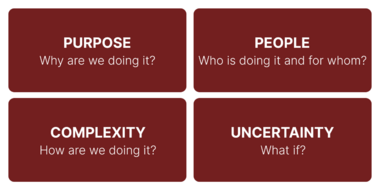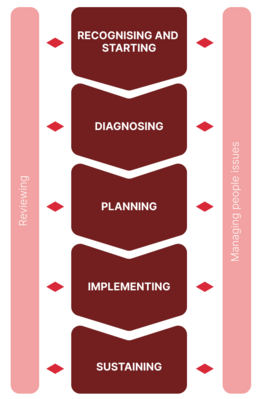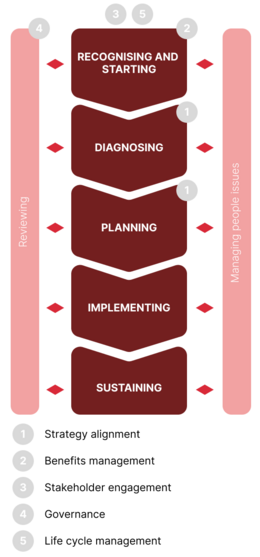The Role of Program Management in an Organisational Change
Developed by Sebbe Sidenius Bull
Revised by Cirkeline Bräuner
This article builds upon an existing piece of work, utilising its structure as a framework to present a new, more comprehensive analysis of the subject matter. Besides the fact that all the content is new, the article is brought to a higher level by creating a clear thread, using recently published references and redesigning the visuals.
In today's rapidly changing society, organisations are going through changes all the time. This causes, that they must be able to adapt to new market conditions, changing customer demands and emerging technology. To remain competitive in a continuously evolving business environment, organisations go through changes such as process optimisation, cost reduction or technology adoption. These are few examples of changes which affect the entire business, and it is therefore crucial that they are managed successfully [1].
Organisational change is a huge alteration for any organisation and can be a daunting task if not managed properly. In the context of project management, organisational change refers to any significant alteration in an organisation that affects the way projects are planned, executed and managed. Managers within the organisation must be able to identify the potential impact of changes in their projects and adapt their project management approach accordingly to ensure successful project delivery [2].
In this regard, program management can serve as an effective tool for managing organisational change. With its comprehensive toolbox of evaluative methods, program management offers a structured approach to assessing each potential change project. This toolbox supports change managers in providing an overview of the change project, ensuring efficient project execution, promoting project alignment, evaluating risks, mapping stakeholders and identifying potential benefits. All of these elements work together to facilitate a more efficient and effective change management process [3].
First of all, this article provides an introduction to what change management is, and different models are involved to describe the process of organisational change. In addition, the four core perspectives of this course, purpose, people, complexity and uncertainty, are used to describe the difficulties and challenges of going through an organisational change. Afterwards, an introduction to program management is given. Then, the two management fields are combined into one common understand of how program management can be applied in organisational change. Lastly, the benefits and limitations of organisational changes using program management are discussed.
Contents |
Change management
Change management is an approach of transitioning individuals, groups, teams or organisations from one state to another state. This article considers change management from the point of view of organisations. To understand what change management is, it is necessary to understand what a change is. This will be further elaborated below.
What is change?
"The act or result of something becoming different" or "The process of replacing something with something new or different" [4] are two examples of a definition of what a change is.
A change is simply a variation in the common way of doing things. It refers to any modification, alteration or transformation in something from its previous state to a new state. Changes occur everywhere and is an opportunity to make or become different through new ways of acting. Changes can be temporary or permanent, positive or negative and gradual or sudden. It can be a source of growth and development as well as a source of challenges and difficulties [5].
Changes are defined as either incremental or radical. An incremental change is a change which happens gradually over time. It involves making small adjustments of an already existing system to improve efficiency, effectiveness and performance. An example of an incremental change is making small step-by-step adjustments in an organisation's strategy. Radical change, on the other hand, is different from incremental change as it involves making a significant change such as introducing a completely new business strategy. Both types of changes can be beneficial for different purposes and choosing the right approach depends on the context [6].
What is change management?
In the section above, the definition of a change was briefly described. This leads to the next topic, which deals with what change is seen from a management point of view.
A simple way to describe change management is with an example. An example of a company which went through a huge organisational change in respond to the COVID-19 pandemic is the Danish jewellery brand Pandora. The company recognised the need for adapt to changing customer behaviour and preferences through new technology adoption, as more customers were shopping online during the pandemic. For instance, the company introduced a video chat to enable that socially distanced customers could chat online with staff members. Other new digital features included the possibility to try on jewellery through virtual simulation and allowing customers to buy products online and collect them in physical stores [7].
Although Pandora went through a successful organisational change, there is unfortunately not a single recipe for applying change management in organisations as the is no one-size-fits-all approach. The process has to be tailored to the specific needs and circumstances of the organisation. However, back in 1951 the psychologist Kurt Lewin has represented a simplified way of viewing a change process [2].
As illustrated in the Figure 1, the change process is divided into three distinct stages; freeze, change and refreeze.

- Unfreeze: The first stage of the change management process characterises the starting point of the change process where the organisation prepares for the change. This involves creating awareness about the need for the change, identifying current behaviours and to get people to let go of their old ways of thinking and working [9].
- Change: The second stage involves implementing the change through planning, communication and execution. The objective is to create new ways of thinking and working. During this phase, people must be trained and educated to adopt new methods and behaviours and to overcome any obstacles that may arise [2].
- Refreeze: The third stage addresses making the new change permanent. The objective is to reinforce the new behaviours, ensuring that they become a part of the organisation's culture. During this phase, the focus is on stabilising the new ways of thinking and working and creating a sense of ownership among employees [2].
What are the steps in an organisational change process?
As mentioned above the change management process does not follow a specific recipe and different models such as Lewis' model can be used to describe the process. However, the author John Hayes proposed another model for change management in his book The Theory and Practice of Change Management from 1998 [2]. Opposite Lewis' model, this model is presented as a more iterative process emphasising that change management is a process with each stage informing and building on the previous stage. Moreover, this models does also include the people perspective of the change. Moreover, this model is also more detailed as it contained more clearly defined stages.
As can be seen on Figure 2, the model is divided into five stages; recognising and starting, diagnosing, planning, implementing and sustaining. These stages are further described below.
- Recognising and starting: The first stage corresponds to the unfreeze stage in Lewis' model. It involves recognising the need for change and acknowledging the specific challenges that drive the need for change within the organisation.
- Diagnosing: The next stage covers diagnosing what needs to be changed and formulating a vision for the desired future state.
- Planning: Once the diagnosis is complete, the organisation develops an appropriate plan for implementing the change. This plan should consider various factors, including resource allocation, budget estimation, timelines and potential risks.
- Implementing: After the change has been planned, the organisation starts implementing it in its operations.
- Sustaining: During the last stage, the changed is sustained and reviewed ensuring that the change is fully integrated in the organisation.
In addition to the five phases, the model also includes reviews and managing people issues during all phases. The involvement of the people perspective in this model highlights the importance of people in an organisational change process. People are a critical component of organisational change processes as they are the ones who must ultimately implement and adopt the change.
Why is organisational change a difficult task?
To better understand and visualise why organisational change can be a difficult task to manage, the topic is viewed from the point of view of the four core perspectives introduced in the course; purpose, people, complexity and uncertainty [11]. The challenges related to change management within each perspective are briefly described below. In addition, the four perspectives are visualised in Figure 3, where the core of each perspective is described by a question.

- Purpose: Before even introducing a change process within an organisation, it is important to clearly define the purpose. Defining the purpose of the change clearly and communicating it to the rest of the organisation can be a challenging task. However, it ensures that the goal and objectives of the change are aligned with the organisation's strategy.
- People: It is human to make mistakes, and as change processes are driven by people, mistakes are also likely to occur. However, people are a necessity to create awareness of the need for the change in the first place. Furthermore, it is also people who are affected by the change.
- Complexity: A change process can be complex to implement successfully in an organisation. This is for instance due to the fact that the process involves difficult tasks such as important decisions, multiple stakeholder, clear communication and effective leadership.
- Uncertainty: Organisational change processes do often involve uncertainty. While the organisation may have a clear purpose of what it wants to achieve, there may be limited information, unforeseen challenges or unintended outcomes that cannot be predicted in advance.
Program management
Changes are often managed less effectively than they might be as those responsible for managing the change fails to handle some of the critical factors of the process as presented above. Not managing the change process in a successful way can impact the entire organisation negatively and ultimately result in the organisation not surviving. In this context, program management and its comprehensive toolbox can be applied to facilitate a more successful change management process.
What is program management?
Program management is a discipline which involves managing a collection of related projects that are designed to achieve a specific goal or objective. Program managers are responsible for ensuring that all projects within a program are aligned with the organisations common strategy and goals, also when changes occur [12].
Program management does often use a framework to keep track of the related projects within the program. An example of a framework is the program management stage mapping which is divided into four stages; identification, planning, delivery and closure. The stage model provides a structured approach to program management, ensuring that each phase is completed before moving on to the next and facilitating effective communication, decision making, and risk management throughout the program life cycle. [13].
Programs are defined by benefits and projects; programs attend to achieve benefits, where the benefits are achieved through execution of projects within the program. The success of a program is measured on to what extend the benefits are achieved. As defined by the Project Management Institute (PMI), programs aim to achieve benefits through the application of five performance areas [14]:
- Strategy alignment: Strategy alignment refers to the process of ensuring that the programs and projects being implemented within an organisation are fully aligned with the overall strategy.
- Benefits management: Benefit management refers to the management of the benefits a program is aiming to achieve. The purpose of this area is that the program delivers the intended outcomes to the organisation.
- Stakeholder engagement: All programs contains stakeholders and the various stakeholders have different interests and requirements. This area refers to the process identifying and engaging with the relevant stakeholders who are affected by the program.
- Governance: Governance includes to the set of policies, procedures and practices that are put in place to ensure that programs are managed effectively and efficiently.
- Life cycle management: Life cycle management covers the process of managing the program and maximising the benefits throughout the entire life cycle.
Each of these five areas serves tools within program management. The areas will later be used to create the connection between program management and an organisational change process presented in Figure 2 earlier in the article.
Application of program management in organisational change
"Program management is a structured framework for defining and implementing change within an organisation" - James J. Leal [15].
As Leal points out, program management serves as a structured framework to help implementing changes successfully in organisations meaning that change management and program management often work in parallel with each other.
To illustrate how there can be created a connection between these two management fields, the five performance areas for measuring program success are mapped onto the change management process presented in Figure 2. However, it is important to mention that these areas can be mapped in different ways, and this is an example of one of the ways it can be done.
The first performance area, strategy alignment, fits well into the diagnosing and planning stages. During these stages, the strategy for the desired change is formulated. Without strategy alignment, the program may fail to achieve the desired outcomes of the change or may even create conflicts with other organisational initiatives. The second performance area, benefits management, is an important part of the recognising and starting stage. This stage includes identifying the desired benefits for implementing the change. The third performance area, stakeholder engagement, is placed above the process, as this stakeholders and people in general are crucial for all stages in the change process. The fourth performance area, governance, is placed next to the reviewing stage. This is due to the fact that the set of policies, procedures and practices needs to be reviews throughout the entire process. Lastly, the fifth and last performance area, life cycle assessment, is also placed above the process. This area includes managing the program and maximising benefits throughout all steps in the change process.
By combining the performance areas and the change management process it is seen that there are a lot of similarities in how the two management fields initiate projects within a program. Moreover, the change management process becomes even stronger by applying the program management performance areas. For instance, the original change management process in Figure 2 does not include the governance perspective, which is very crucial when going through an organisational change. However, the combined model also shows where gaps remain when change management and program management are combined. For instance, the model neglects the financial part such as financial management, procurement management, resource management and risk management [14].
Benefits and limitations
Through the article, an understanding of what change management and program management each entail has been created. In addition, the two areas have been combined in a unified model. Finally, the limitations and benefits of the two fields and the unified model will be discussed.
Limitations
- No one-size-fits-all approach: As explained in the beginning of the article, different models can be used to describe the process of implementing organisational change (Lewin and Hayes' models have been provided as examples). The fact that there is no one-size-fits-all approach for implementing change can make it difficult for organisations to create a procedure for the change as there are many ways of approaching it.
- Potential gaps in unified model: The combined model presented in Figure 4 addresses that there remain financial management gaps when combining the two management fields. The fact that gaps exist and there is not defined a general approach for using program management in organisational change can challenge the organisations and make them afraid of even planning a change.
- Increased complexity: Combining the two management fields can increase complexity among the organisation's staff and make the change process even more difficult to navigate.
Benefits
- Enhanced communication and collaboration: By combining the change management process and the program management performance areas, the communication and collaboration between these fields are streamlined and it helps to identify and resolve potential conflicts, dependencies and risks.
- Improved visibility and control: Program management tools and practices provide a comprehensive view of all the projects involved in the change process. This allows organisations to identify and resolve difficulties early, allocate resources efficiently and track progress effectively.
- Increase risk management: Program management enables organisations to identify and reduce risks across projects. This helps to minimise the impact of potential problems on the overall change process.
Annotated bibliography
For further reading on the topic or related topics, the reader is encouraged to check out the following material:
Facilitating change, Lauge Baungaard Rasmussen, 2011
- This book presents a guide for people who want to facilitate change processes within their organisations. Moreover, it provides a framework on how to assess whether an organisation is ready for a change which has not been covered in this article.
The theory and practice of change management, John Hayes, 2010
- This book has been involved in some part of this article. However, it includes other relevant important information related to change management which is not covered here. For instance, the book provides different practical tools for managing change processes including the Lewin's change model, Kotter's eight-step model and action research.
Leading change, John Kotter, 1996
- Lastly, this book discusses why change initiatives often fail due to the fact that they are not following a structured process. In this context, the book provides successful and unsuccessful examples of various change initiatives.
References
- ↑ https://www.prosci.com/change-management Change management, last visited 03-03-2023
- ↑ 2.0 2.1 2.2 2.3 2.4 2.5 Hayes, J (2010). The theory and practice of change management, Palgrave Macmillan, New York
- ↑ https://www.prosci.com/blog/change-management-and-project-management-comparison Change management and project management: a side-by-side comparison', last visited 06-03-2023
- ↑ https://www.oxfordlearnersdictionaries.com/definition/english/change_2 Definition of change, last visited 02-03-2023
- ↑ https://www.igi-global.com/dictionary/chaos-and-complexity-approach-in-management/3646 What is change, last visited 06-03-2023
- ↑ Hodges, J (2016), Managing and leading people through organisational change, Kogan Page, England
- ↑ https://d3.harvard.edu/platform-digit/submission/how-pandora-the-jewelry-retailer-managed-to-win-during-the-pandemic/ How Pandora, the jewelry retailer, managed to “win” during the pandemic, last visited 03-03-2023
- ↑ https://expertprogrammanagement.com/2021/09/unfreeze-change-refreeze/ Unfreeze, change, refreeze, last visited 02-03-2023
- ↑ Kotter J. P (1996). Leading change, Harvard Business School Press, Boston
- ↑ http://unchange.pbworks.com/w/page/26958422/Generic%20Process%20Model%20of%20Change Generic process model of change, last visited 03-03-2023
- ↑ 11.0 11.1 https://www.doing-projects.org/perspectives Project management perspectives, last visited 02-03-2023
- ↑ https://www.pmi.org/learning/featured-topics/program Definition of program managment, last visited 02-03-2023
- ↑ https://www.projectsmart.com/articles/framework-for-programme-management.php A framework for program management, last visited 06-03-2023
- ↑ 14.0 14.1 https://www.projectengineer.net/the-5-parts-of-program-management/ The 5 parts of program management, last visited 02-03-2023
- ↑ http://www.projectsmart.co.uk/programme-management.php Project smart programme management a structured framework for implementing change, last visited 06-03-2023

